Scope details that can make – or break – a crossbow system.
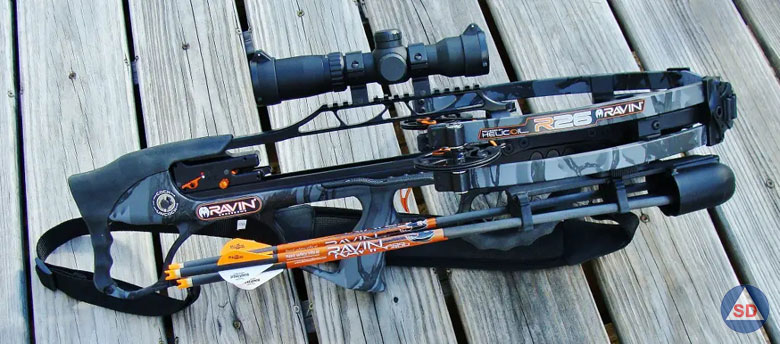
Crossbow scopes are quickly becoming a standard addition to modern crossbows. The longstanding taboo associated with crossbows seems to be rapidly disappearing as a number of state wildlife management agencies attempt to control their burgeoning deer populations. Beyond the negative effects of over-populated herds upon the animals, for humans, the concerns extend to deer-vehicle collisions, the spread of tick-borne diseases (Lyme and several other strains) and the destruction of crops or ornamental shrubs.
Striking a positive chord, for both new and experienced deer hunters, this situation has provided new crossbow opportunities. And since many of us “experienced” hunters are no longer spring chickens the timing is fortuitous. A further win: The resulting increased demand is driving real equipment improvements. These extend to their aiming systems; some type of trajectory-compensating scope.
But my state was late to the gate. Until 2020, I was one of a small group of hunters who could legally use a crossbow during our archery deer season – but only through a special disability permit. Its issuance was far from assured (mine, granted due to an old injury, required documentation from the VA) so, for most archers crossbow technology was more of a nebulous thought. If your area is crossbow legal, and you’re thinking of taking the plunge, you could be in the same boat. In that case, read my overview article on crossbow deer hunting.
Experienced vertical bow hunters could be presumed to have a leg up. Also, beyond all-important hunting skills, the rifle-type configuration of a crossbow should shorten the physical learning curve. Valid points yes but, as I discovered, horizontal bows can also introduce a number of new “issues.”
The Crossbow Connection
My first crossbow, purchased back in 2013, was a Parker Terminator, sold with a lifetime warranty (so much for that; they’ve since gone out of business). No complaints regarding its downrange performance though, even to this day. Despite subsequent developments, it was easy to master, and also quite accurate. However, it did introduce a few unexpected headaches.
For starters, the “loading” process was relatively complicated, requiring the aid of a rope & pulley system. And it was a true PETA to maneuver through thick woods. With game at hand, the critical timing related to the drawing a conventional bow was eliminated, but the actual “shot” was loud – as in closer to a subsonic .22 LR! On a positive note, its 20-inch bolts departed with more speed than my vertical bow’s 28” arrows, although the difference was less than expected.
Trajectory was flatter but still parabolic, posing similar range and overhanging brush concerns. And, if no action transpired, uncocking required shooting the bow (I used a special bolt and portable capture target). Also, its basic fixed-power 4X trajectory-compensating scope was nothing special.
Accuracy & Velocity vs Range
Today’s crossbow market is more competitive, so some of these issues have been addressed (such as built-in uncocking systems). Velocities are trending upward too, although physics are still involved.
An example: Despite my Terminator’s s 175-pound draw weight, its shorter 13-inch power stroke was less efficient than that of my 28-inch, 65-lb. compound bow. Still, its velocity was quicker, reaching 340 fps. Some recent introductions are considerably faster but, because the entire archery industry has been busy, others aren’t that far ahead of today’s vertical evolutions.
How about accuracy? Even from 40 yards, shooting more than one bolt at the same bullseye assured their rapid destruction. Encouraged, I stretched the range, successfully launching bolts to 70 yards – well beyond the 50-yard range-compensating capabilities of its included scope. The accuracy was there, but the loopy flight of the bolts was disconcerting. Several recent model I’ve since shot were as accurate, and some were 60 fps faster but, advertising hype to the contrary, trajectory is still a concern.
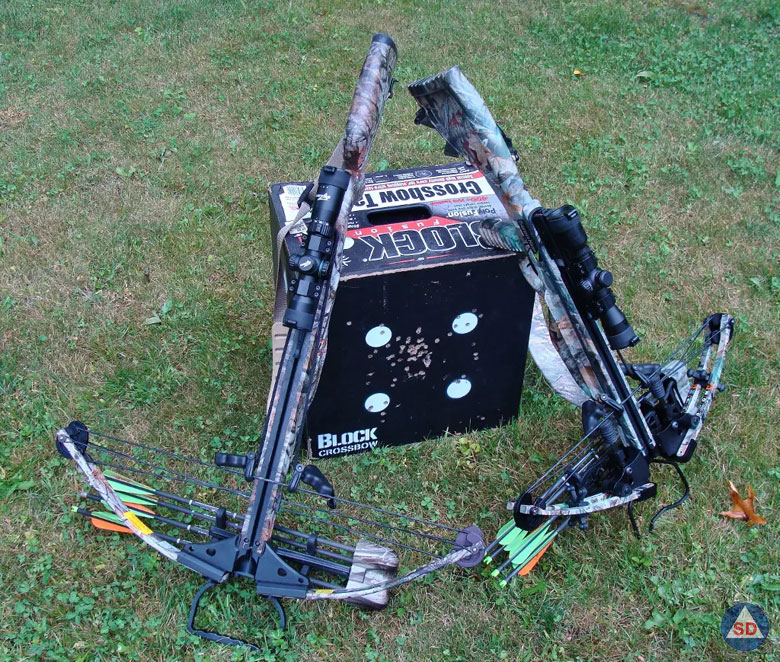
Range? Particularly at further distances, precise yardage is essential (bolts can also be affected by wind). In the woods, overhanging branches can cause further problems so, even with a good rangefinder, my hunting distances remained conservative.
- Model #182444 - RX-FullDraw 5 Rangefinder
- Archer's Advantage bow ballistics uses your arrow weight, arrow velocity, and peep height to calculate more accurate ranges for steep angle and long distance shots.
Flight time entered into this decision, too. The shot itself was loud so, given enough distance, an alert deer could “jump the string”. For these reasons, although my comfortable shooting distance did increase somewhat, 30 yards became a prudent outer limit.
That said, in suitable conditions, with some of today’s fastest crossbows, the right scope can stretch that distance. That’s true to some extent for nearly any hunting-legal crossbow. Eventually, I upgraded mine to an illuminated 30mm, range-compensating “variable” that could be calibrated to specific velocities.
Crossbow Scopes 101
A friend plunked down good money for a hi-tech crossbow rated to hit 400 fps. Depicted in videos accurately slinging bolts at 100 yards, it shipped with a decent scope that was similar to the one I purchased. Its special reticle could accommodate such ranges but, being an experienced hunter, he intended to hunt in thicker deer havens. Thus, after following the sighting-in procedure, he established a 40-yard max.
Once in the woods, he also followed a common rifle hunter practice, dialing the scope’s magnification to a lower setting (to gain a wider a field of view). No excitement during the first few outings, but a subsequent zero check on a 3-D deer target quickly spiked his blood pressure. Somehow, his bolts were way off the mark at 30 and 40 yards begging the question, “what the #$%^’ is up?”
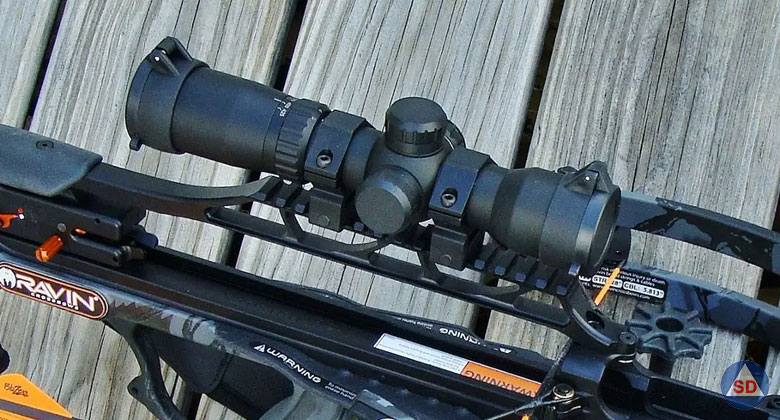
Details Matter
Answer: The scope was fine; the problem was operator error. As it should be to optimize the crossbow’s performance – like most sporting-type rifle variables – it’s a second focal plane design. As such, the size of its reticle (along with its trajectory compensating hold-over points) remains constant regardless of the scope’s magnification setting.
But, of course, these adjustments change the apparent size of the target. And this expansion or contraction of the image against the reticle alters the relationship of its hold-points to change their “ballistic” values – which could be bad, or good thing, depending on how the system is used. We were able to easily sort these details out because my system works the same way.
The Basics
My present crossbow scope fits the above description. But apparently, it’s been designed to minimize shooter-induced errors. Devoid of magnification inscriptions, its rotating “power ring” displays just the velocity-settings, common to many crossbows (see photo).
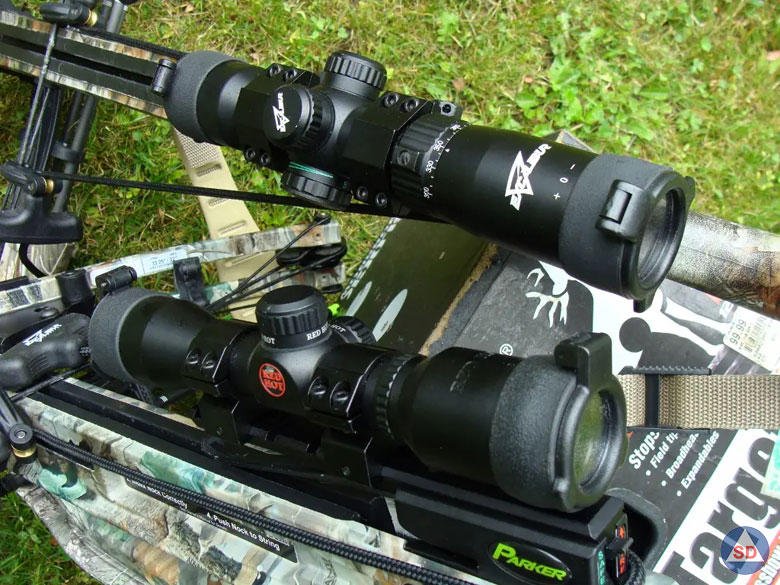
For this reason, unlike 2nd FP range-compensating rifle scopes, its reticle isn’t optimized for use at a specific magnification – typically the maximum. Instead, it utilizes more or less magnification to accommodate a diverse range of trajectories. Summarizing the process, the normal power settings are replaced by speeds (in fps), a trick that alters the values of the trajectory-compensating reticle. I’ll use my scope to illustrate how they work.
Setting Up a Crossbow Scope
My replacement scope is an Excaliber Tact Zone. As noted above, this 30mm scope features an illuminated reticle with range-compensating hold-over points that can be calibrated to the specific velocity of the crossbow. Its speed-settings run 300 – 400 fps. The latest but nearly identical model is the Tact-100.
The main difference, reflecting the performance of some recent bows, appears to be extra settings to cover 450 fps. But the mounting process is identical and follows standard rifle procedures. A video in this link covers the details:
No products found.
The scope’s 30mm Picatinny-type rings (included) easily mounted to the crossbow’s rail with enough a latitude for proper eye-relief. But I did take pains to ensure the scope was level! Otherwise, windage errors would appear while using the reticle’s longer-range aiming points.
Velocity Calibration
Having chronographed my crossbow, I knew it did an honest 342 fps, so I adjusted the scope accordingly. Interestingly, its velocity settings were at oddball intervals of 300, 320, 350, 380 and 400 fps. Why? The scope is actually a lower-power 2½-6X, so I’m guessing the velocities correspond with normal magnification settings. I chose a spot just below “350” and aligned it with the reference dot. The next step involved “sighting in” the scope via its central crosshairs.
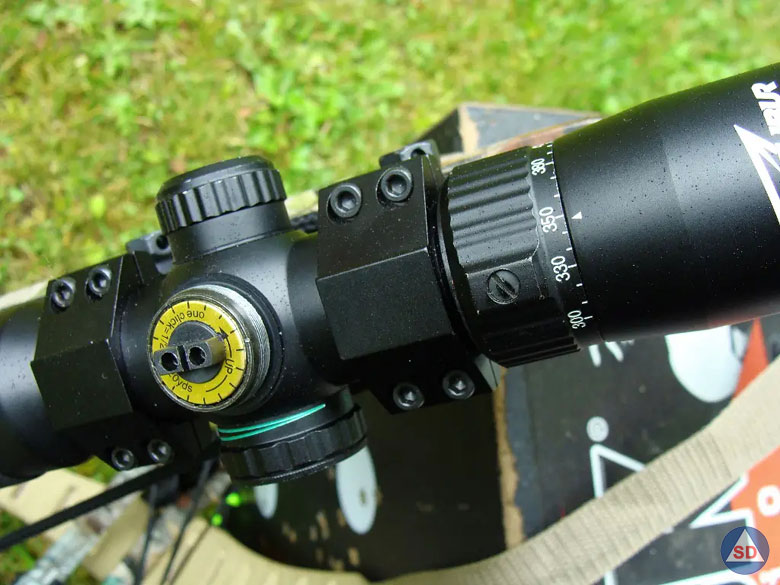
Establishing a Baseline Zero
The actual zero process, similar to a standard rifle scope, involves elevation and windage turret adjustments, although their “click” values may differ. My basic 4X offered fairly common ½ MOA clicks, the equivalent of a half-inch at 100 yards. However, each click of the scope we’re discussing was worth ½-inches at 20 yards: 2 ½-MOA per click! Actually, this makes sense with a 20-yard baseline zero – a familiar distance for many archers.
Of course, bore-sighting is out with a crossbow so it’s worth starting out closer, preferably with a generous backstop. The first bolt I shot was near enough to the mark from 10 yards for a move to 20 yards, where the turrets easily put bolts on the money (if not, a prime suspect would’ve been incompatible bolts).
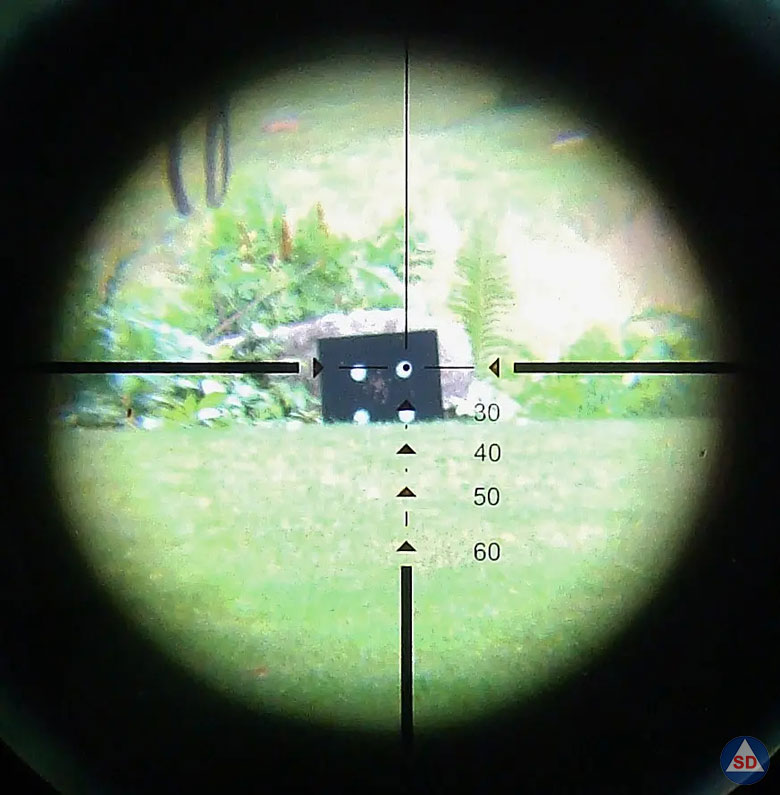
Stretching the Range
With the 20-yard zero established, at the scope’s proper speed setting, my average-weight bolts should strike close to reticle’s 30-, 40-, 50-, and 60-yard hold-points – if the manufacturer did its part. To find out, I set up a target stout enough to capture the bolts (sometimes a challenge in itself). Then, using a rangefinder, I shot several from each distance, steadied by a set of shooting sticks (accuracy was preestablished). Better to use a bench rest and reset the target but be sure to keep your fingers clear of the string!
Wrinkles?
Judging by the spot-on groups, Excaliber had done its homework. But, what if your impact points differ? In that case, play with the velocity settings while shooting more bolts.
This process can be further simplified with a steady rest. Say your bolts strike 3-inches below your bullseye at 40 yards. Leave a bolt in the target, realign the reticle’s 40-yard mark with the bullseye and note where your central crosshairs (the 20-yard baseline) are aiming. Then, while carefully maintaining their position, adjust the scope’s speed dial until the 40-yard mark coincides with your bolt. Good chance that setting will cover the other yardages, too.
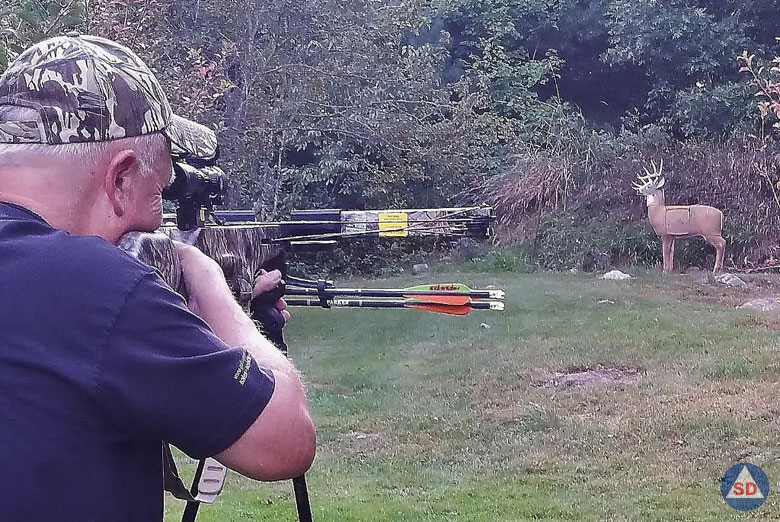
Either way, shoot enough bolts to confirm.
Fixed-power Crossbow Scopes – and Others
Starting with fixed-power crossbow scopes, since most have similar reticles, if yours doesn’t provide close hits, you could try a few bolts at modified distances until scoring a close match (be sure to record this data). That was the fix for my spare crossbow, sold with another basic 4X scope. Its reticle was close but not exact. But it does jibe at slightly modified yardages; 38 instead of 40-yards, etc.
Actually, you could use nearly any scope, although compensating for steep bolt trajectories would be difficult. You could dial come-ups via the elevation turret – although reality will likely dictate otherwise. See my article on bullet drop compensation for more information.
What about first focal plane scopes? Popular among long-range rifle shooters, they eliminate magnification-induced hold-over concerns because both the target’s image and the reticle shift in harmony. However, at lower magnifications the reticle grows finer, making it harder to resolve in low light.
Most also feature complex grids and target turrets. Like a standard rifle scope, you could conscript one for a crossbow duty, but the result would be a “fiddly” system.
Dot sights fall somewhere in between. Most are spinoffs of firearms models. The few versions built for crossbows often feature multiple dots, but some are generic regarding trajectory compensation. That said, they’re small, intuitive and eye-grabbing, especially in low light. Then again, so is an illuminated crossbow scope.
Parting Shots
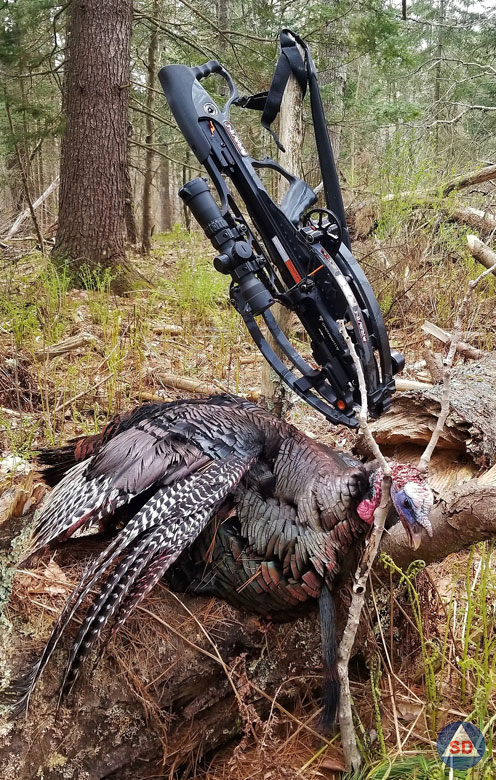
Most of us archers are wired to think “range” in 10-yard increments (frequently off a 20-yard starting point). Thus, the archery industry follows suit.
Having used all of the above optics, I much prefer a purpose-built crossbow scope, an illuminated version with a provision to match its reticle to the velocity of the bow. And the better crossbow packages have this base covered – to include the right bolts, another key component of the system! Most will easily cover 50 yards; more than enough range for most of us.
An average-sized doe from 2015 is still among my more memorable archery events. If a “trophy” is the standard, we (the few hunters in my circle) have certainly tagged much “better” deer. Ranked by distance though, that 42-yard shot topped my archery list. Others – particularly Western hunters – will probably find this laughable. But for many Eastern archers it’s a pretty good poke. And for all, there are ways to muff a shot – the reason I doublechecked my scope’s velocity setting before taking the shot.
My two closest compatriots hunt with fast Ravin crossbows, an R-20 (420 fps), and R-26 (400 fps). Their bows were purchased as packages with Ravin-branded scopes. Checking the latest versions, I noticed the scopes (which can cover 450 fps), now incorporate “speed locks” – good insurance!
Still, like me, they both prefer to stick with closer distances. And we all take pains to ensure our crossbow-rated hunting broadheads fly true!
In closing, if you’re looking for crossbow scope recommendations, the Internet is a better source for up-to-date reviews. The list of decent picks is growing, a good indicator of demand.

